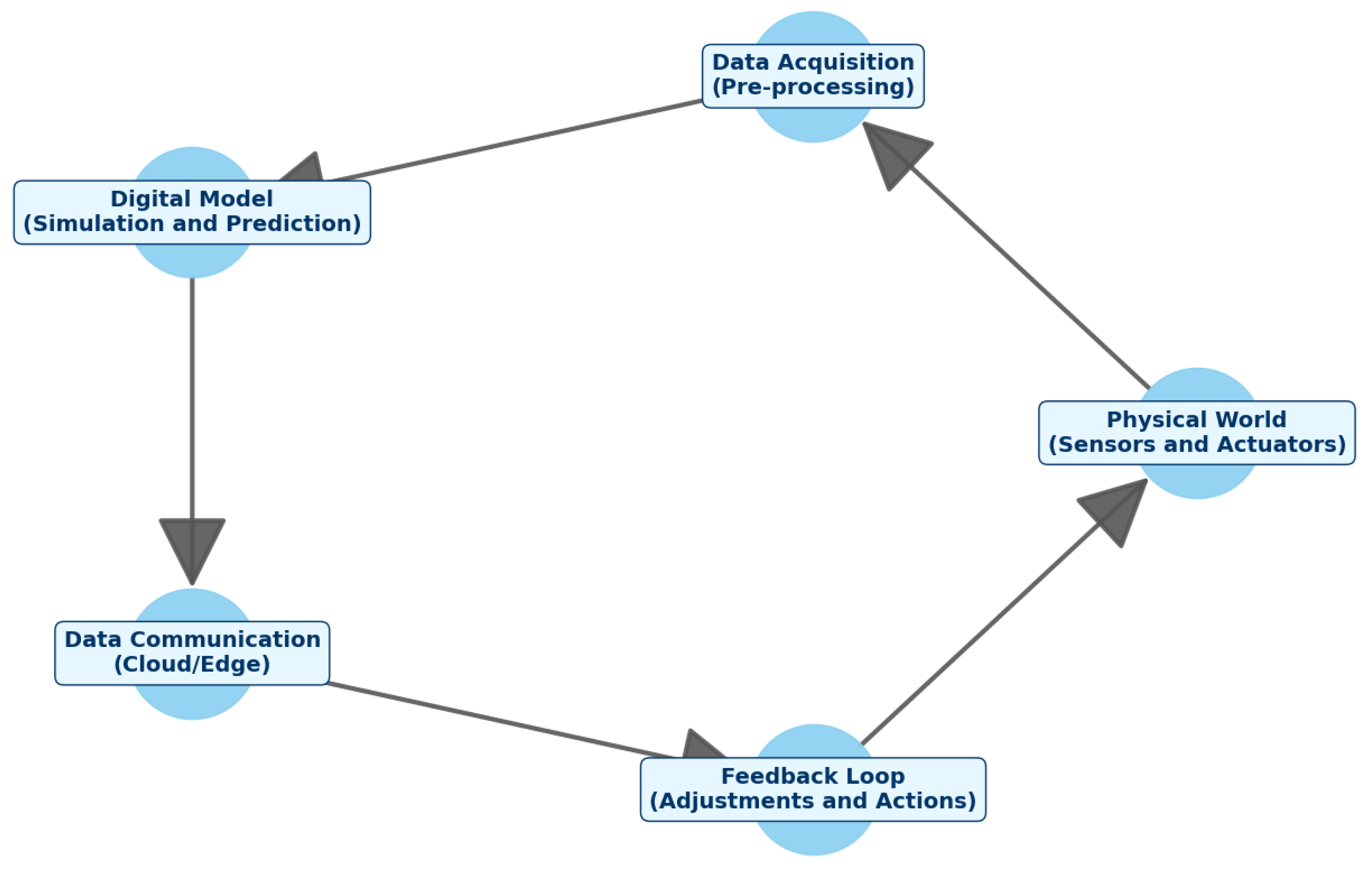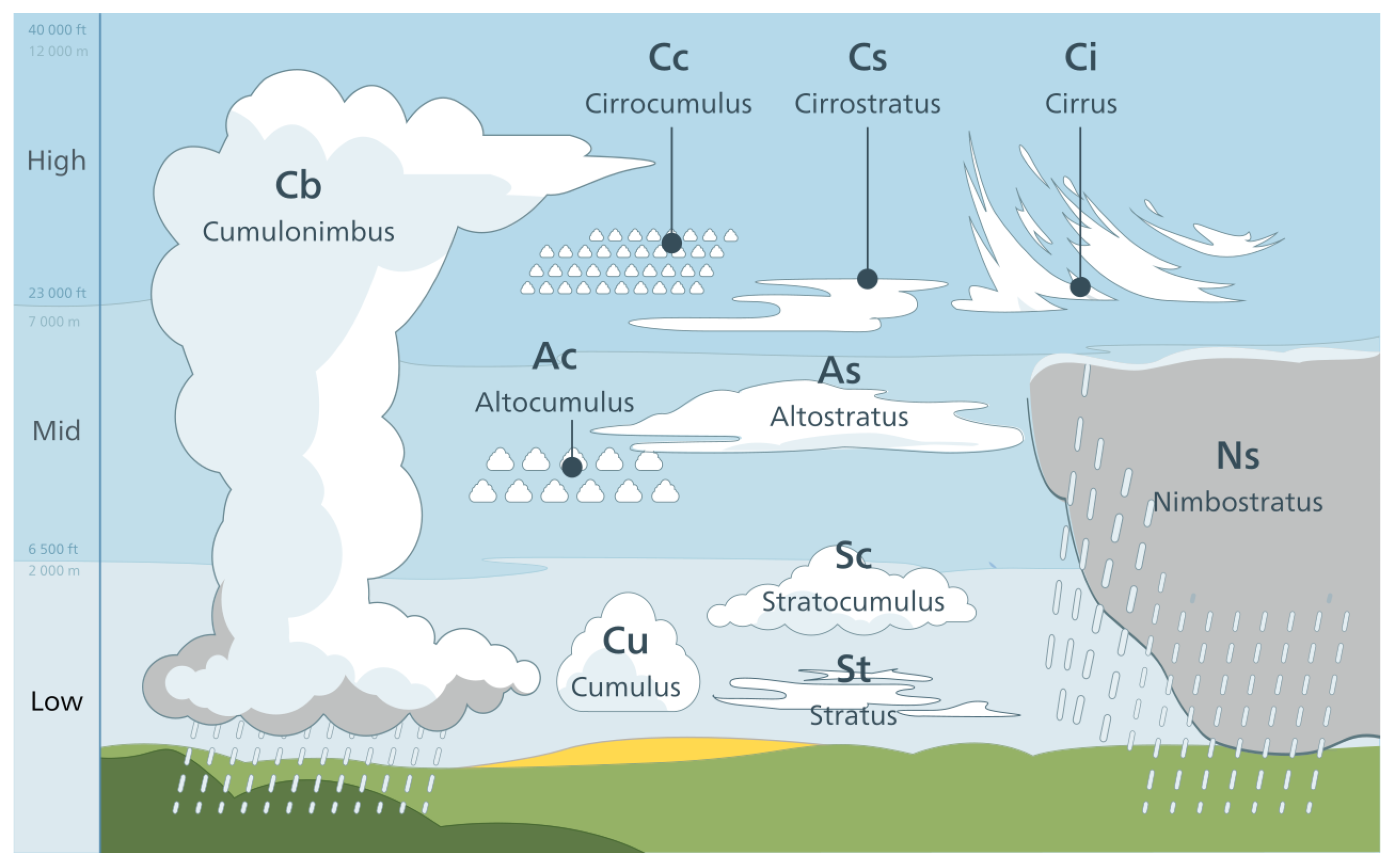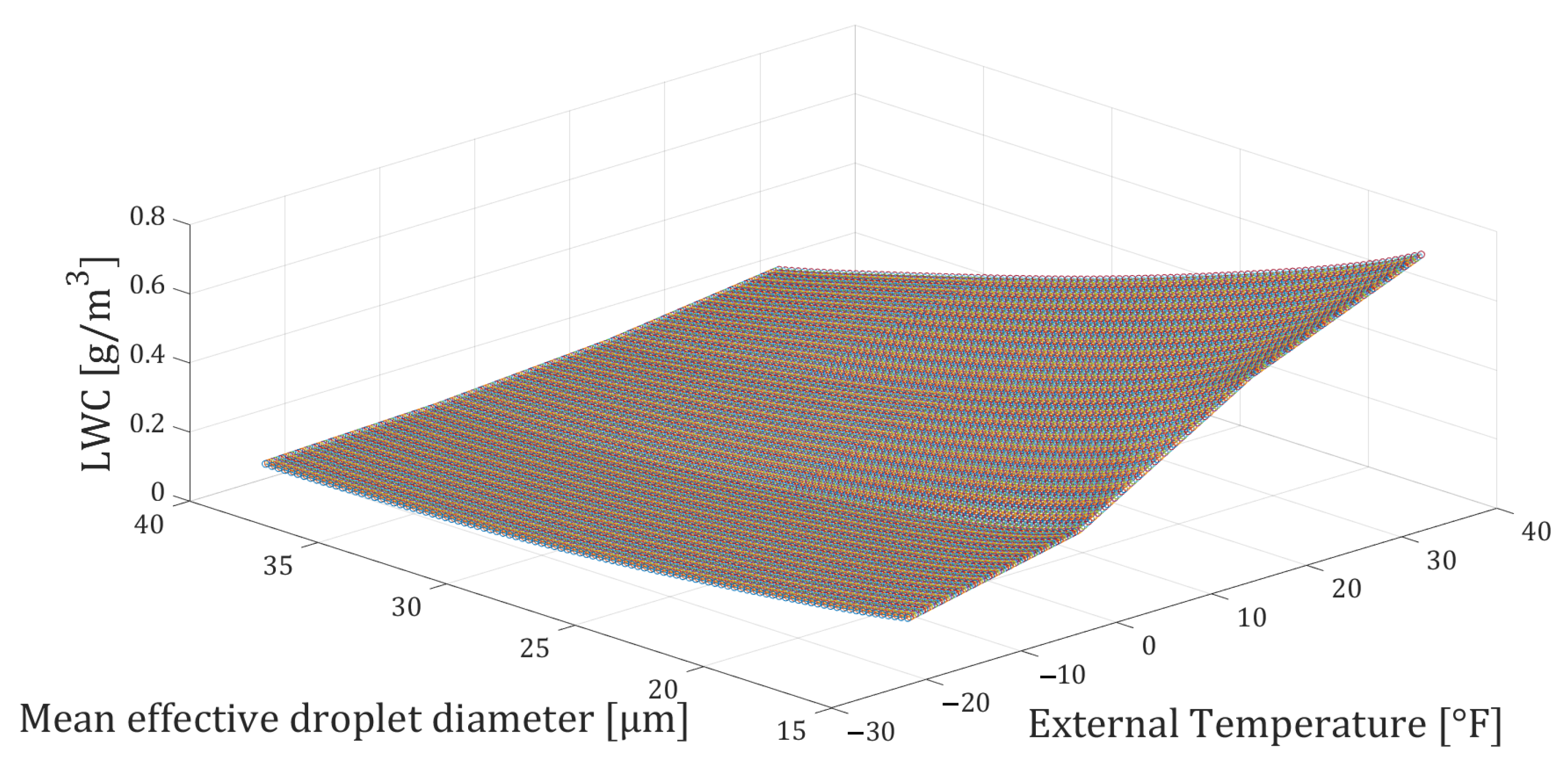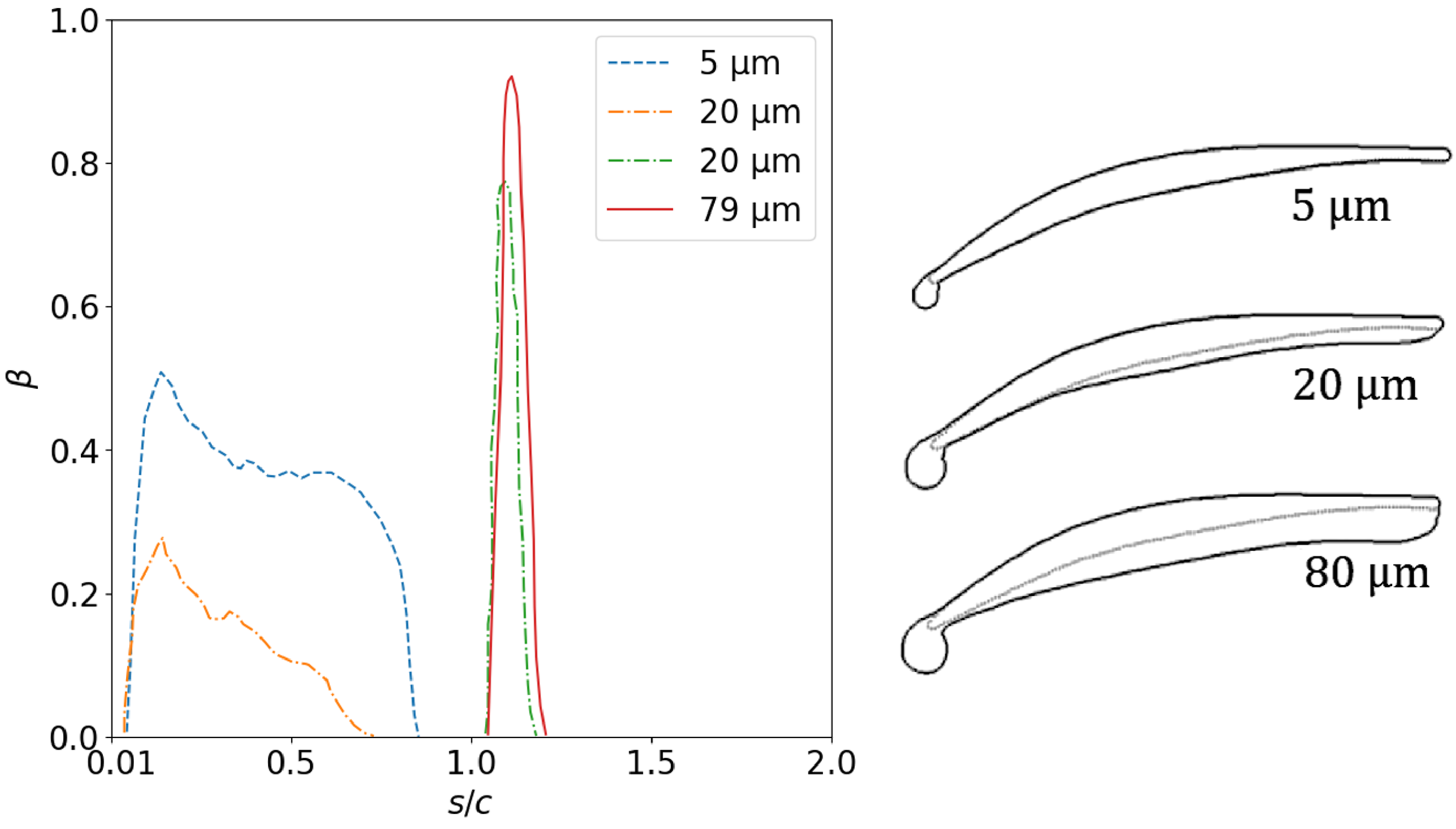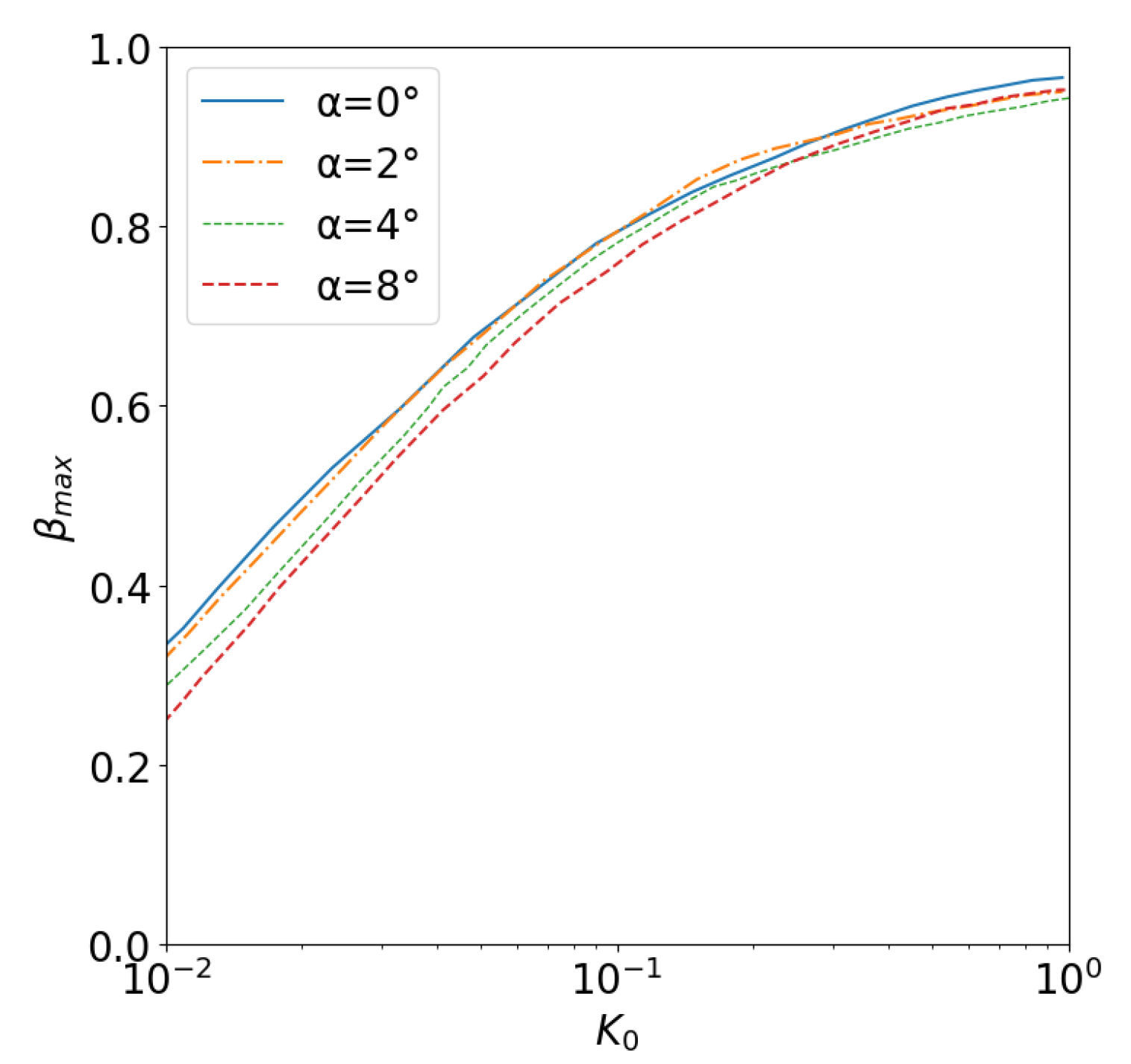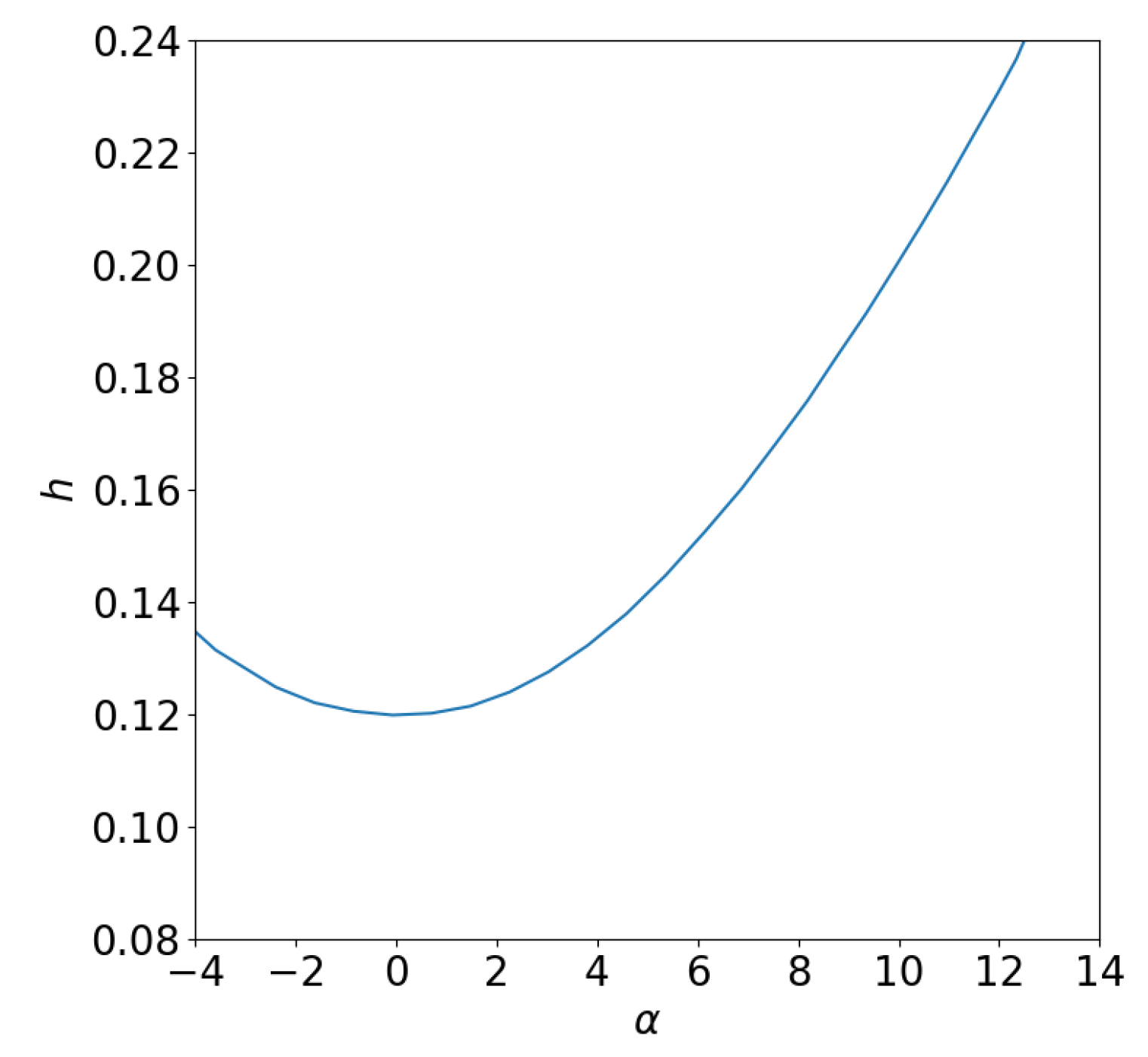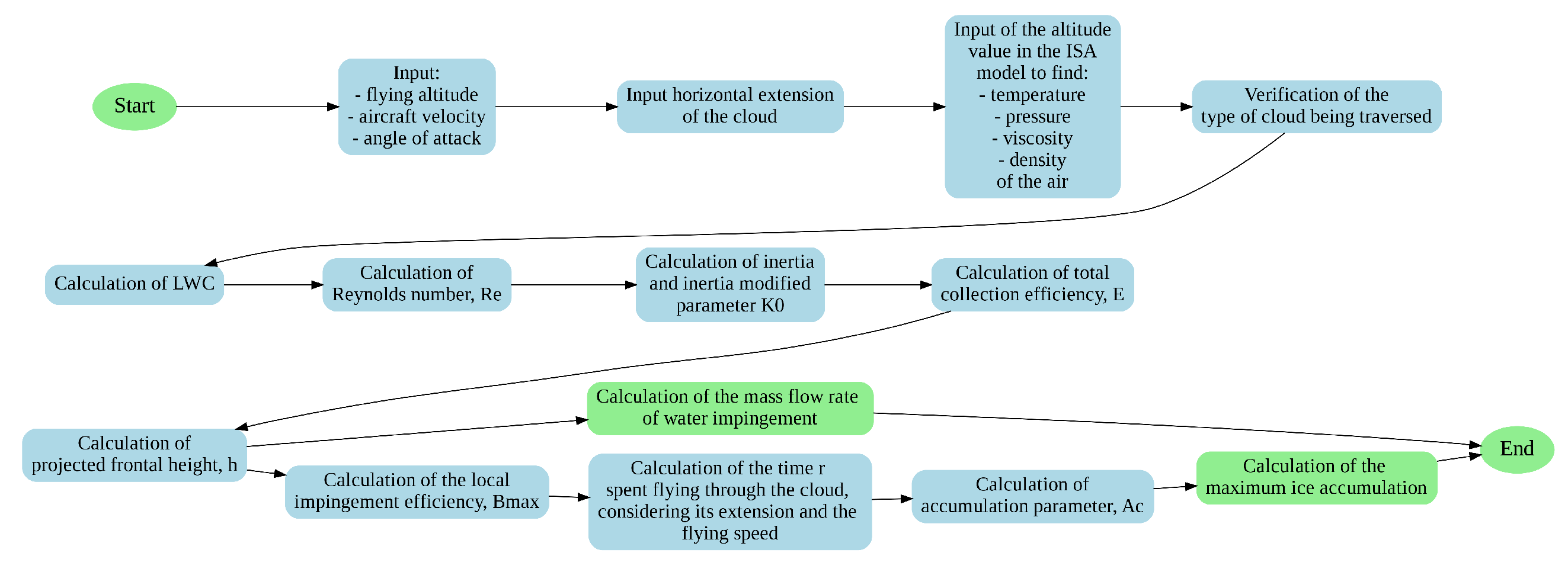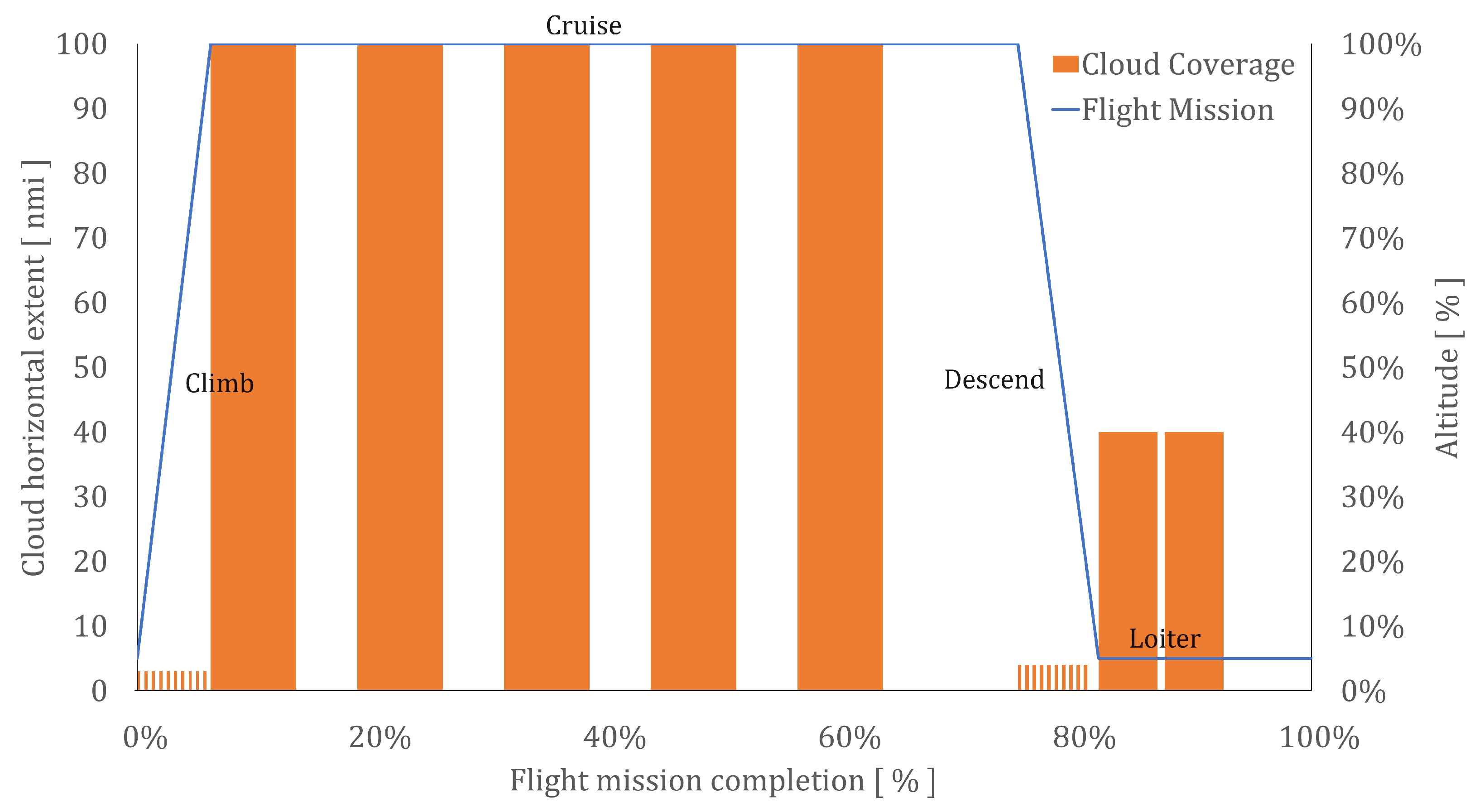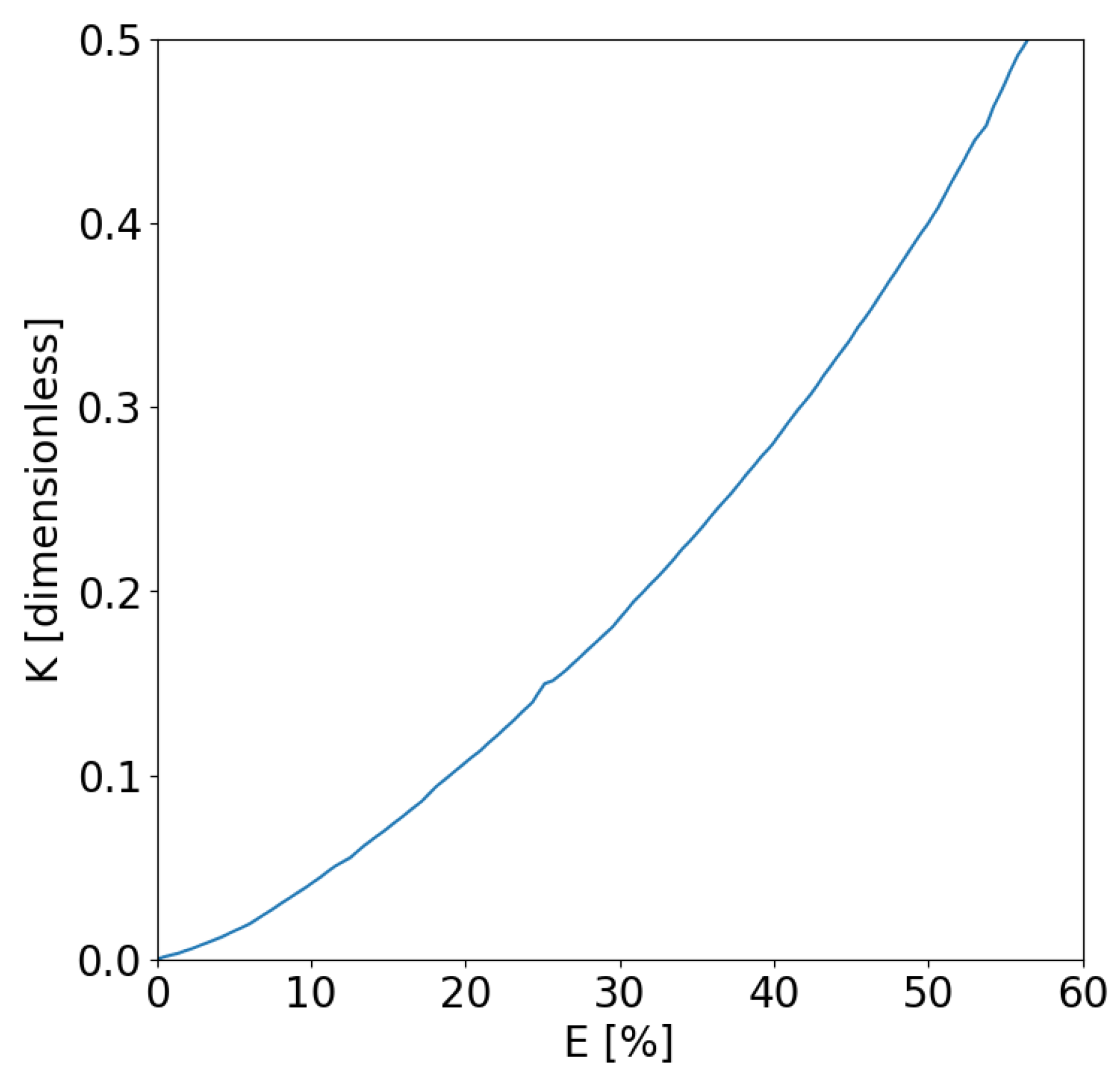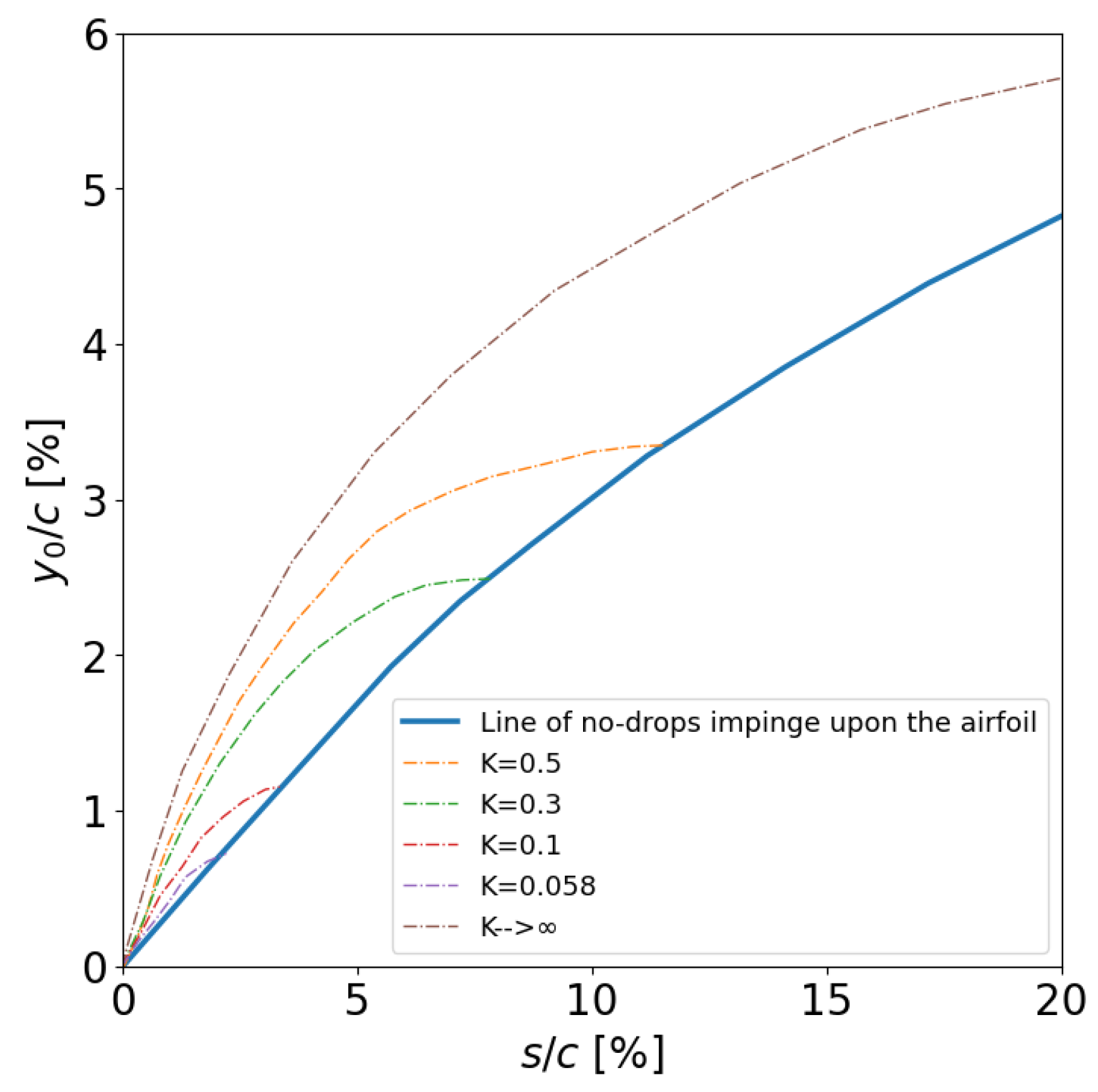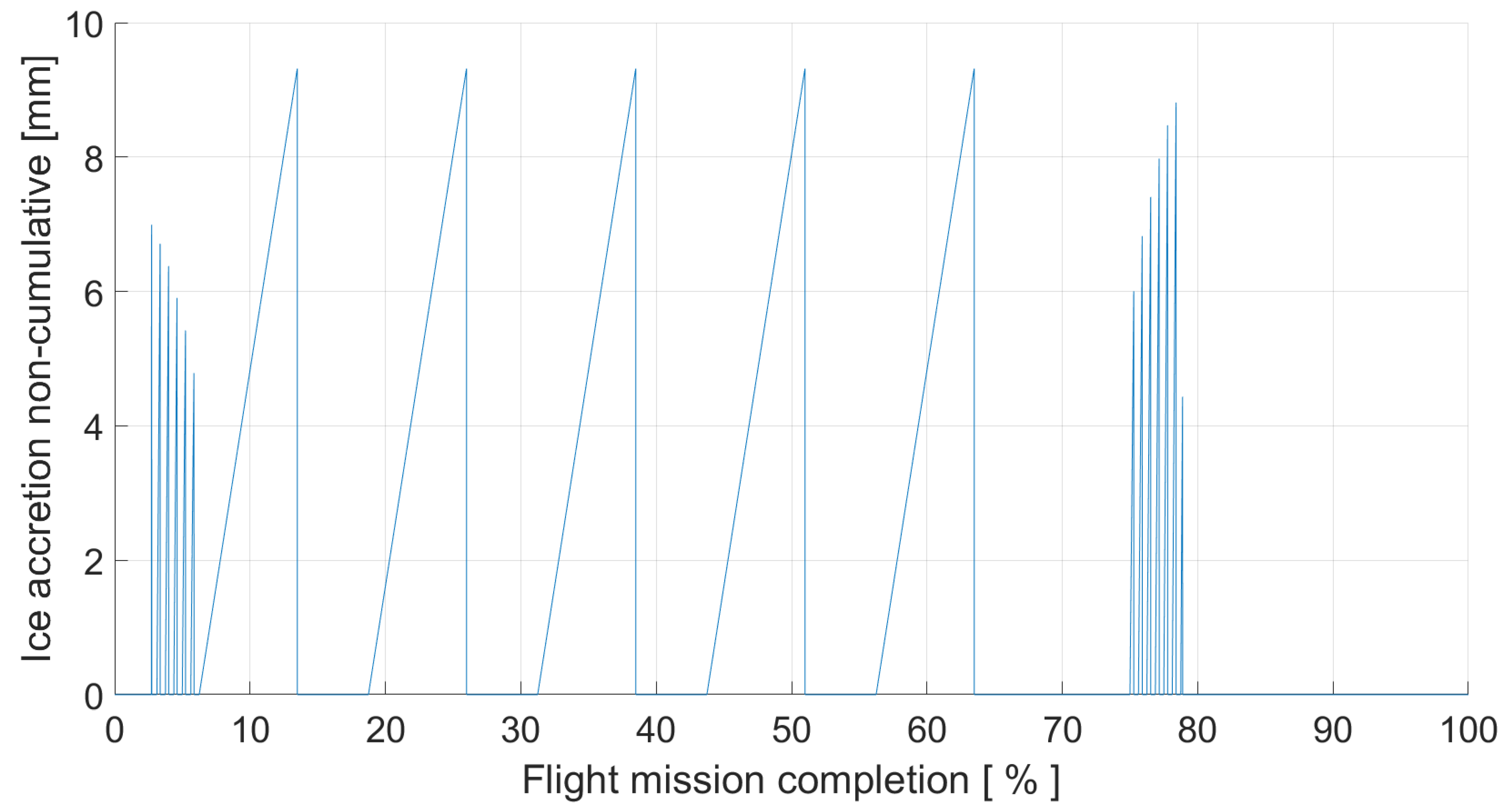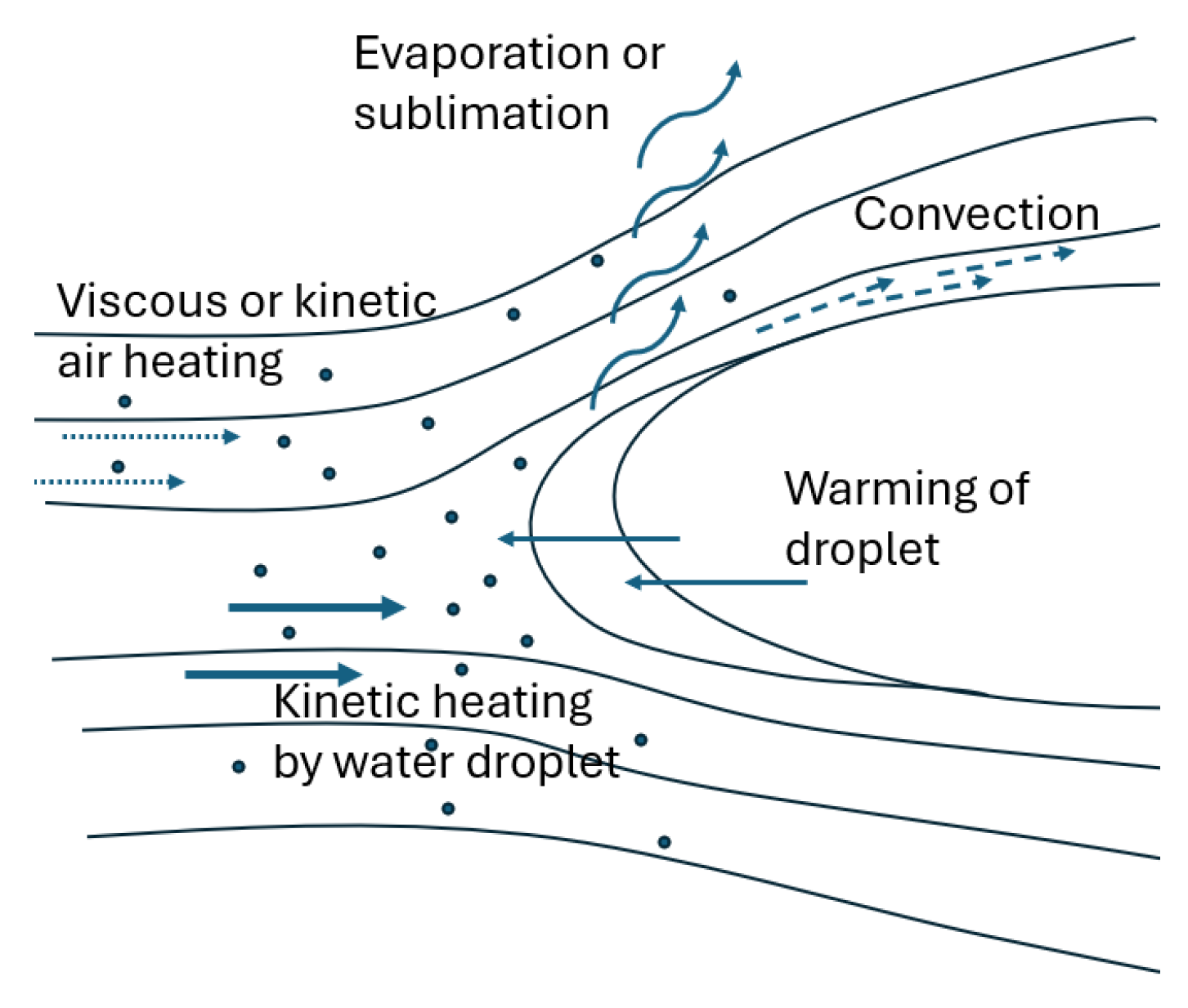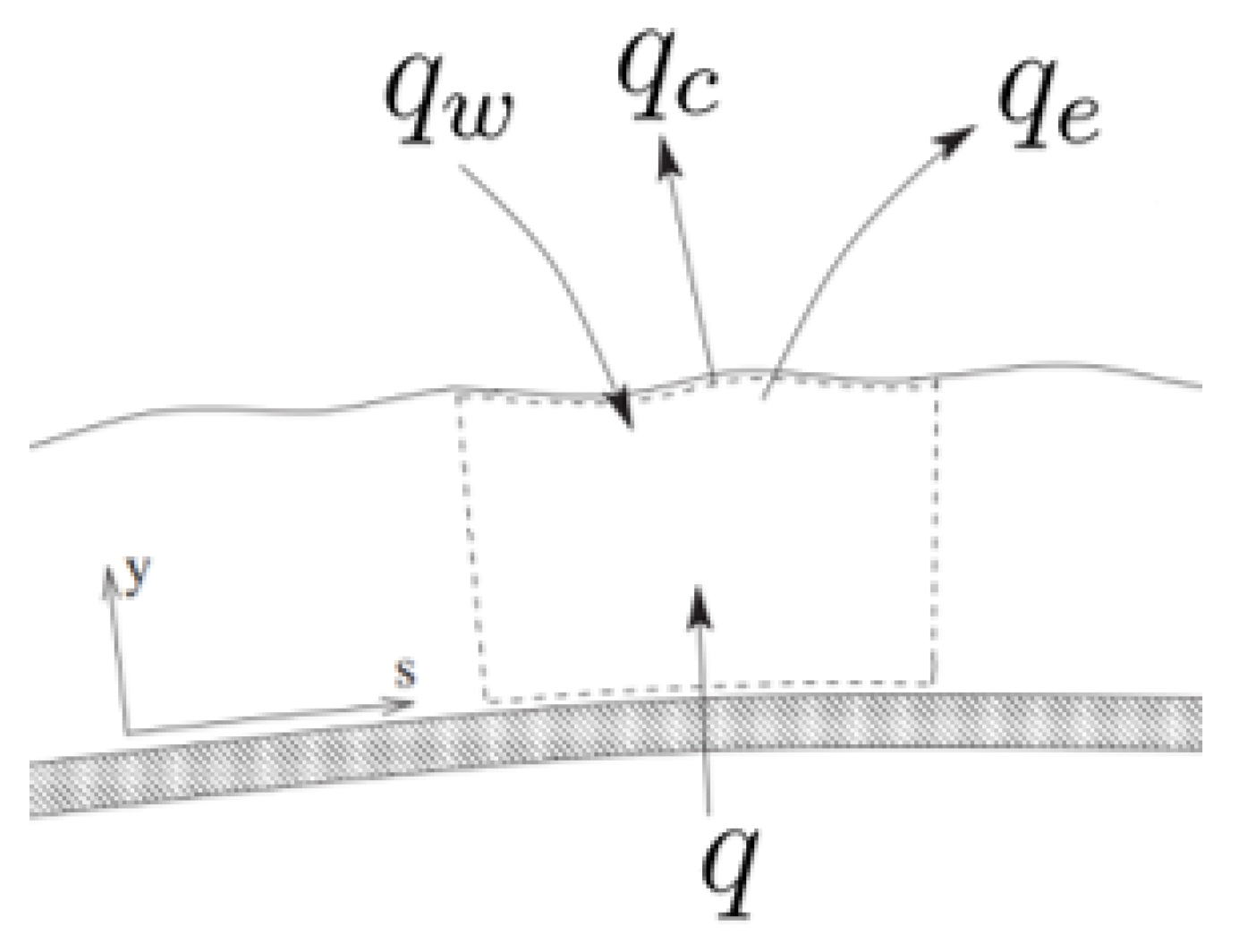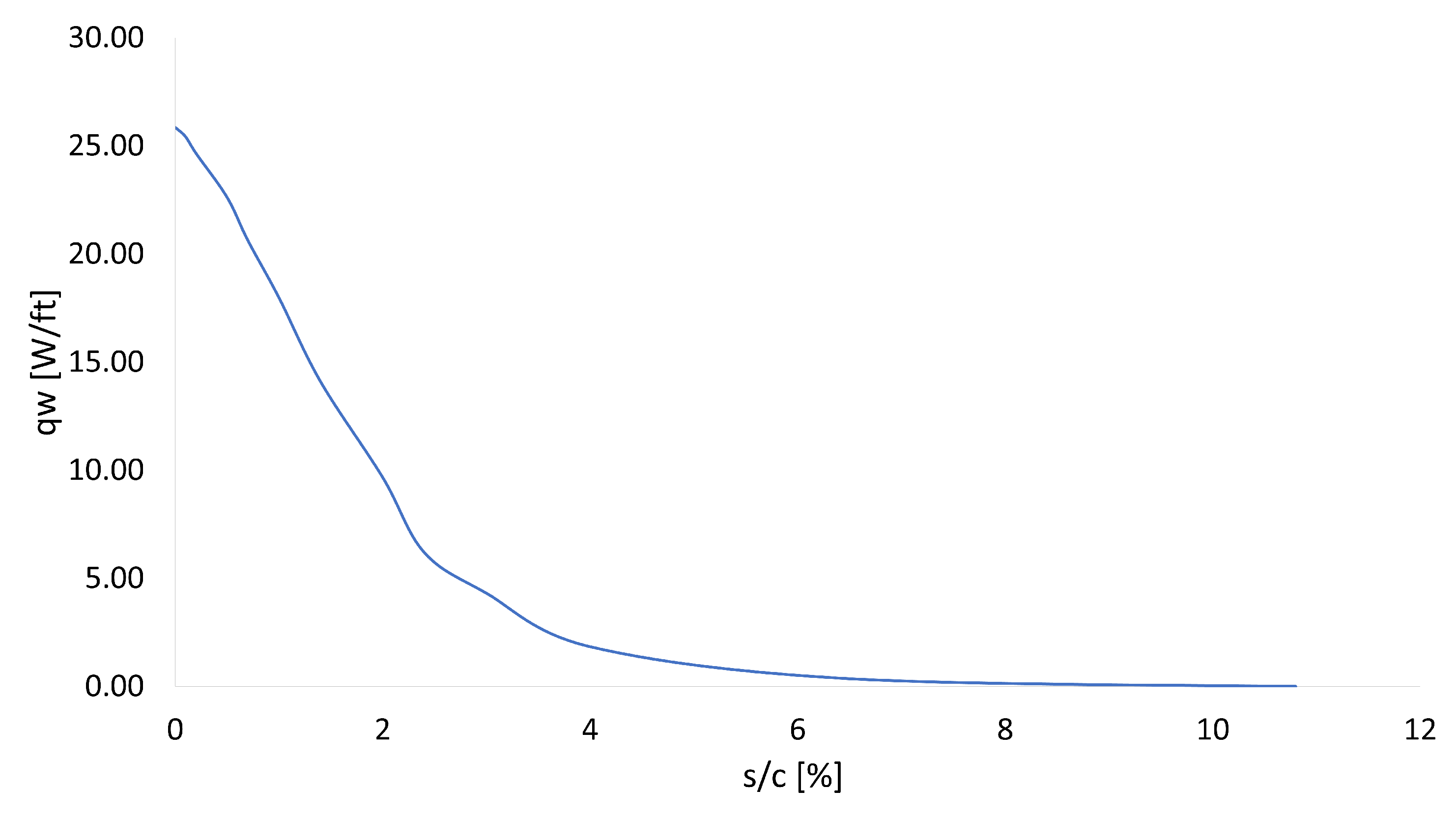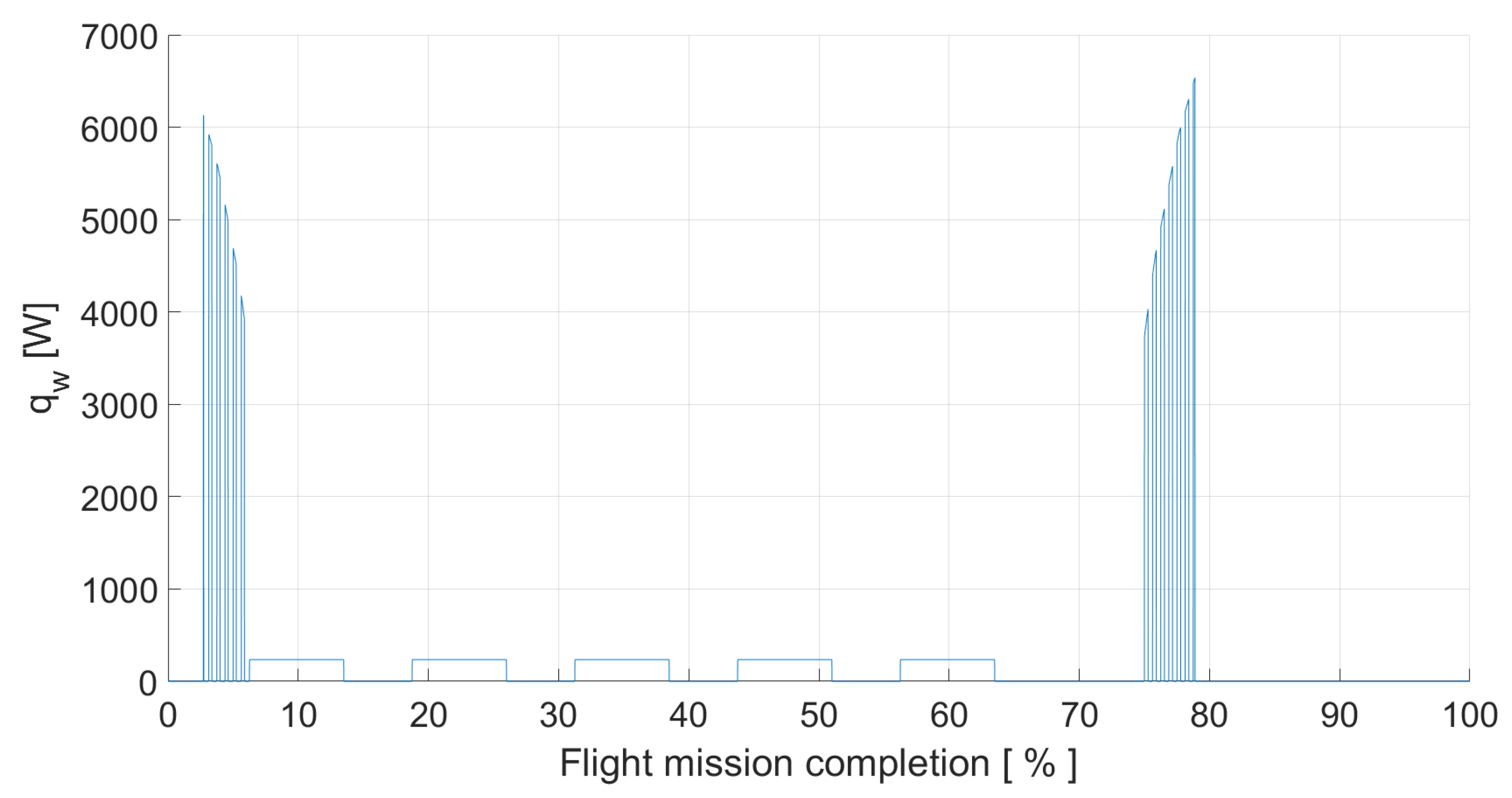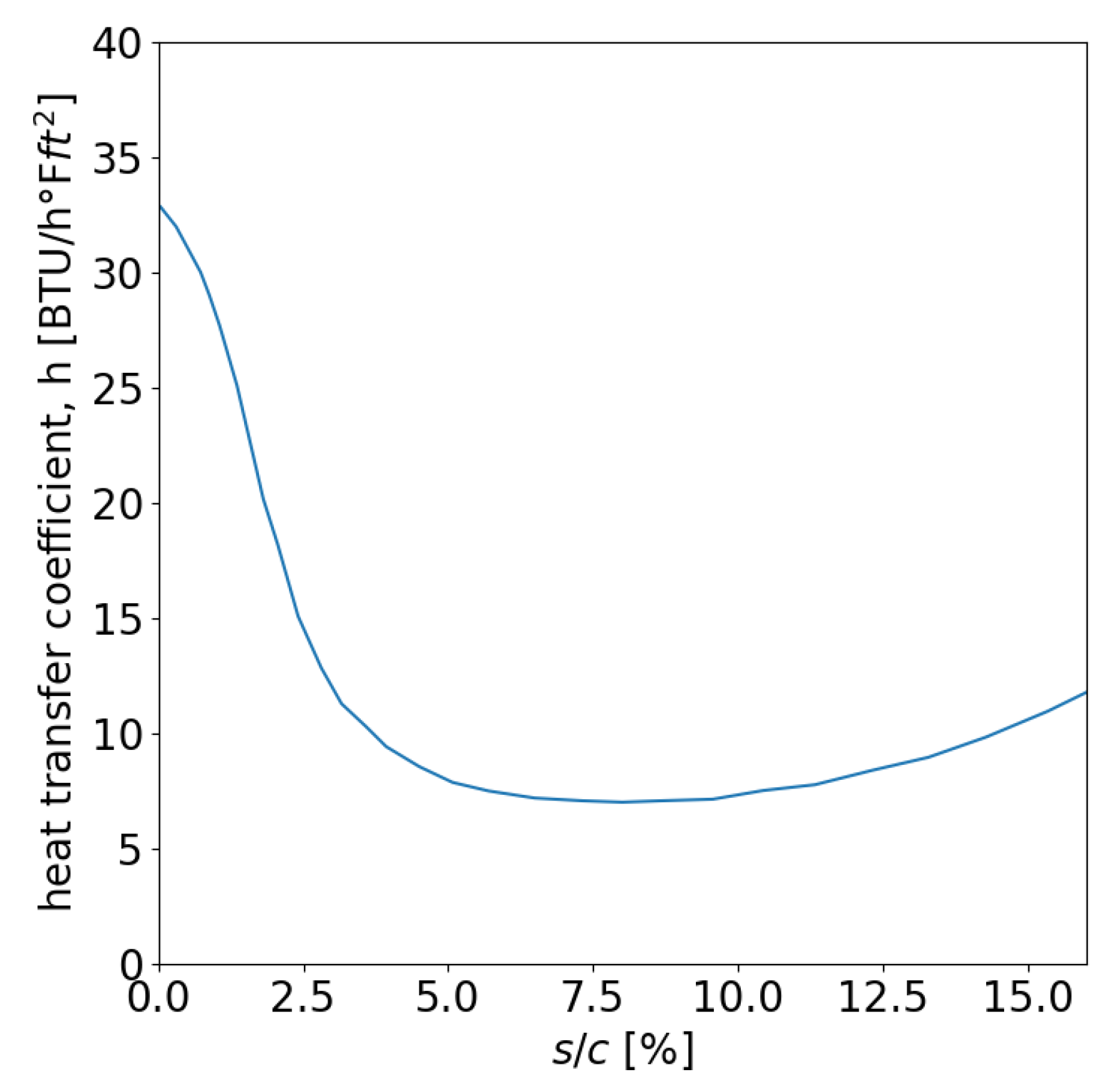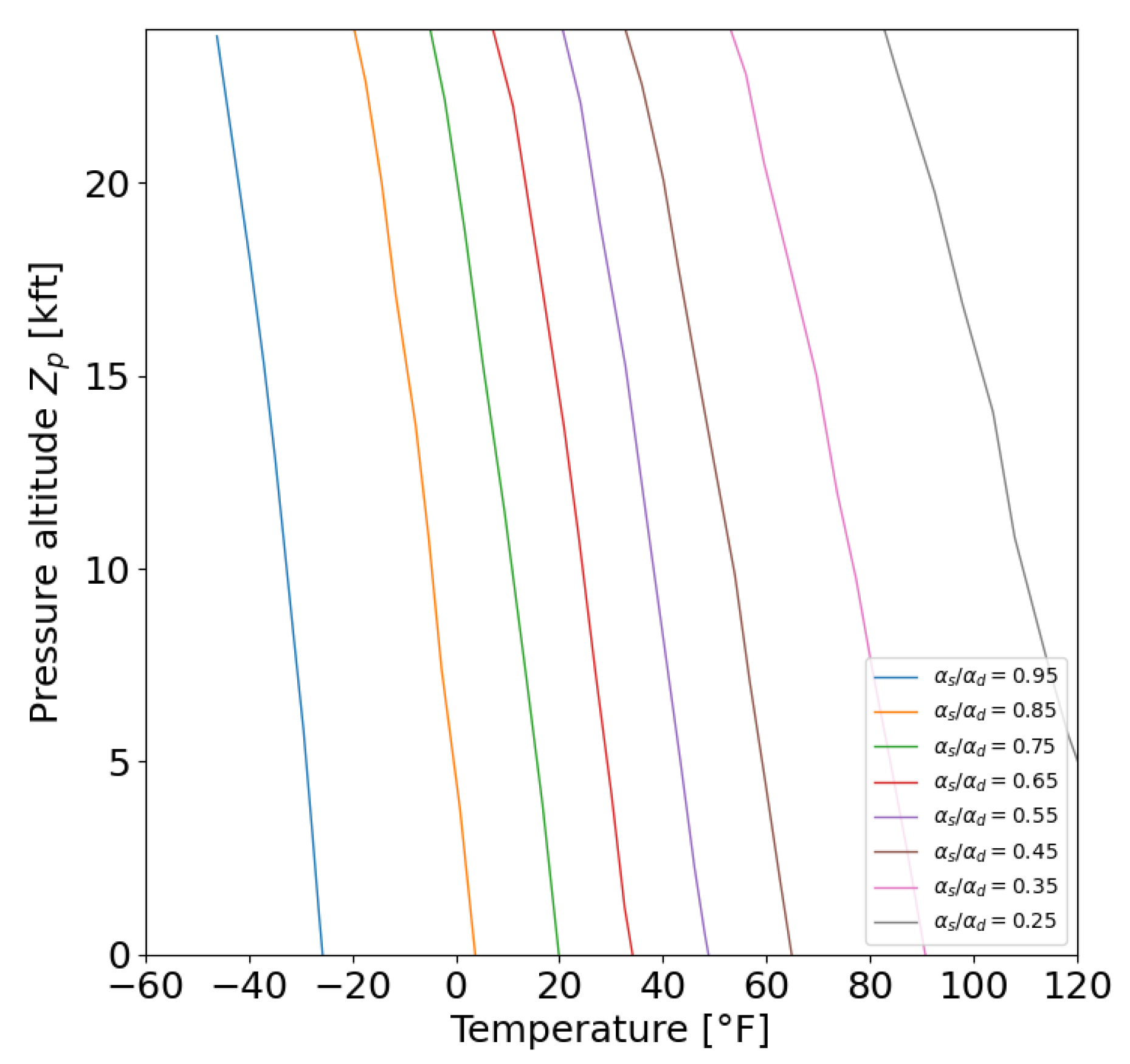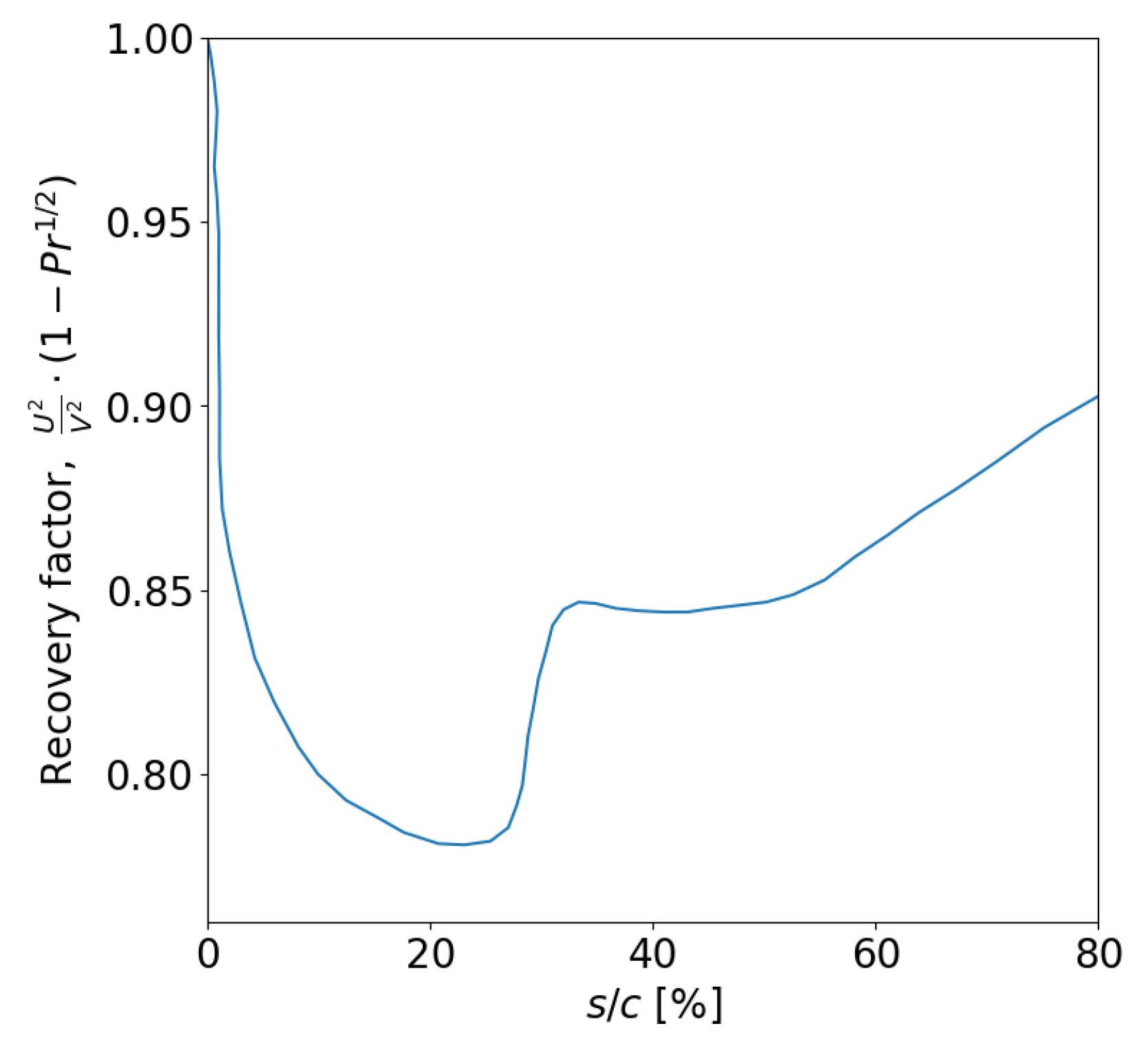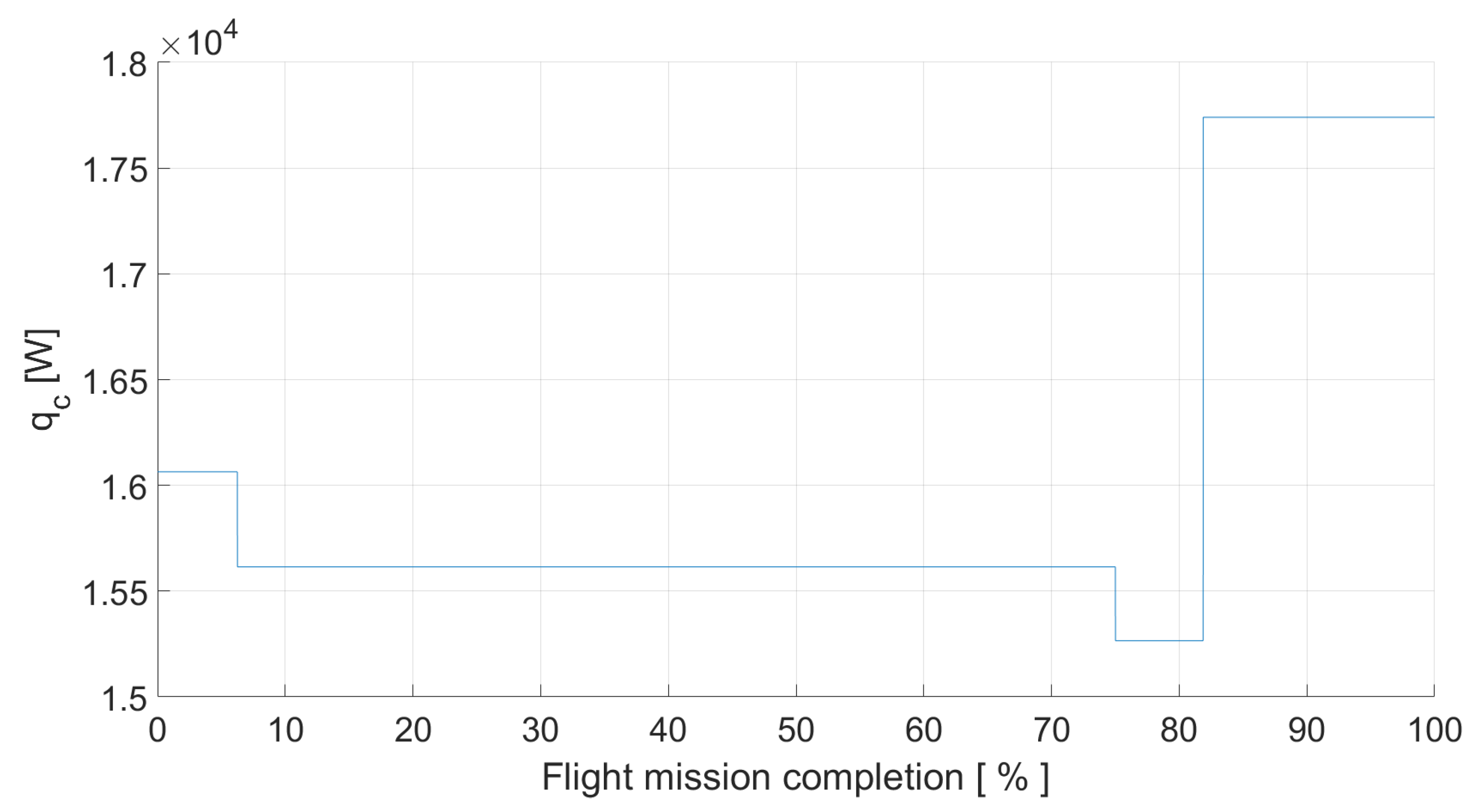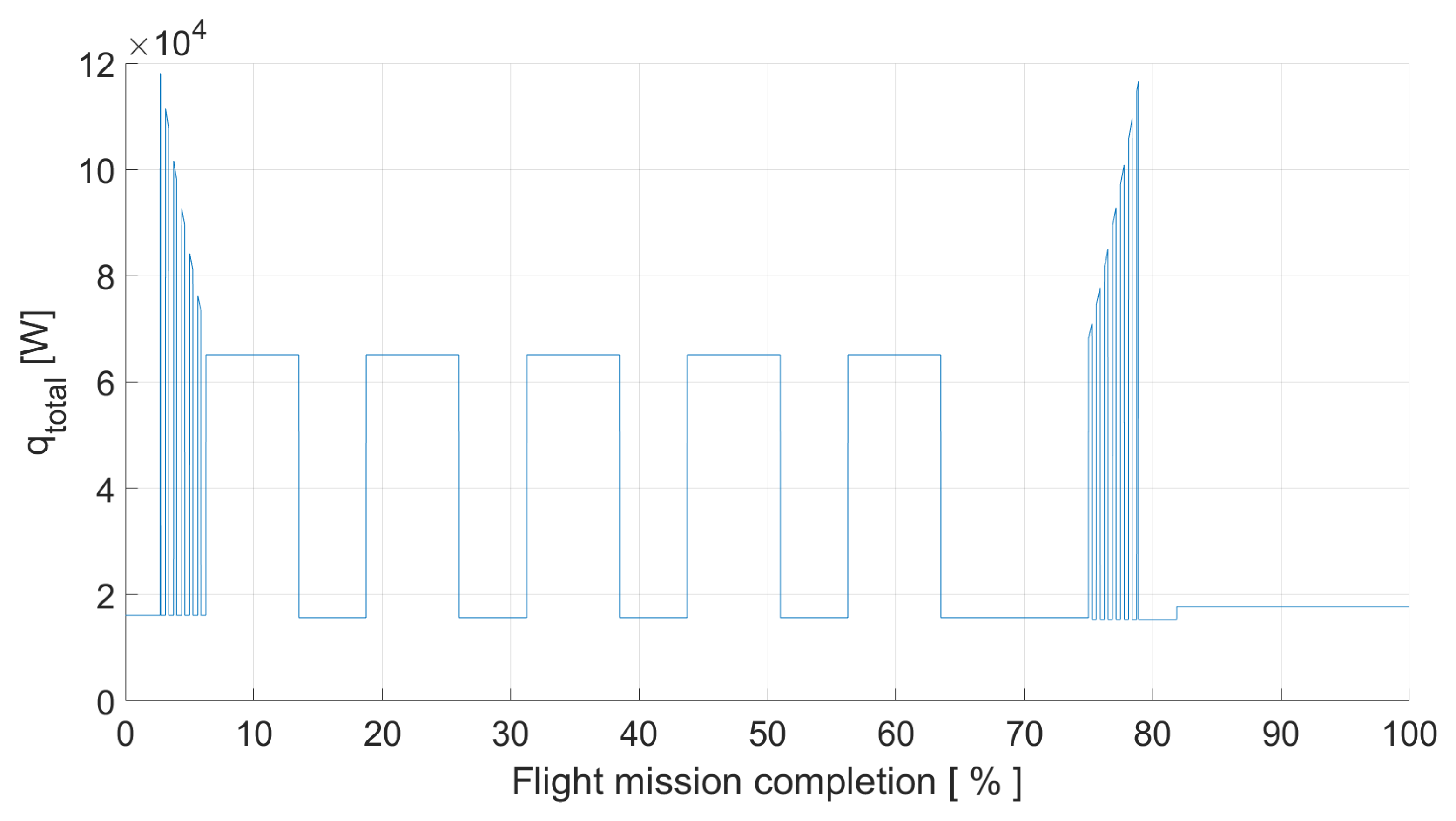To develop a predictive model for assessing the icing conditions experienced by aircraft wings, the Appendix C in EASA CS-25 regulation is analyzed. This Appendix has been applied to extract icing-associated cloud parameters, such as LWC, MVD (Mean Volume Diameter) and environmental temperature, along with the relationships between these parameters.
3.2. Calculation of Impinging Parameters
Supercooled clouds typically contain less than 1.0 g/m3 of liquid water in the air. This low concentration of water in the free-stream allows considering the particles present in that stream as they were uncoupled. Consequently, they have small impact upon the surrounding flow. When particles can be considered uncoupled, analyzing the overall flow as the sum of the individual contributions provided by each particle is possible. Moreover, the behavior of each particle can be studied separately by considering forces acting on it. Those contributions can be then summed to obtain a general identification of the whole flow.
In atmosphere, those droplets are typically less than 60 μm in diameter and can be approximated as spherical, because of their low Reynolds numbers. The trajectory of a single droplet approaching an object can be described by the following equation:
where
m is the droplet mass,
is the droplet acceleration in approaching motion, and
and
are the pressure gradient and apparent mass, respectively (these terms are typically neglected because the density of the water droplet, i.e., the particle, is much greater than that of air, i.e., the fluid). In the above equation,
represents the gravitational force, which can also be neglected due to the very small mass of supercooled water droplets.
denotes the Bassett (unsteady) “history” force: this term adjusts the drag factor for a sphere undergoing acceleration. The force
accounts for the modification in the flow pattern around the particle compared to the steady-state condition, capturing the influence of the particle’s motion history on the immediate force [
15].
is the drag force and the only factor that will be considered.
Equation (
1) will then undergo a process to introduce non-dimensional parameters and incorporate the inertia
K and the modified inertia
, as follows. Considering the vector
, its components are
x and
y; their dimensionless values are defined as
x* = x/c and
y* = y/c, where
c represents a characteristic length (in this application, the chord of the airfoil). The variables
t and
denote the time and free-stream airspeed, respectively. After appropriately reorganizing the equation, the following non-dimensional form is obtained:
For simplicity, in subsequent equations, the asterisk will be omitted. As can be observed, the Reynolds number and droplet inertia K are key parameters characterizing the trajectory equation.
The Reynolds number of the free-stream droplet is:
where
is the air viscosity, and
K is:
Applying the Langmuir and Blodgett theory [
16], the variables
and
K can be combined into a single parameter
, known as the modified inertia, which accounts for the influence of droplet size and, from a mathematical perspective, representing the Stokes number.
Furthermore,
establishes a connection between droplet inertia and drag forces. When
assumes small values, drag forces dominate, causing the droplet to align with the flow streamlines until it closely approaches the object impacted. When
is sufficiently small (e.g.,
= 0.005), the droplet behaves as a flow tracer, following the fluid path. Conversely, higher values of
indicate a predominance of droplet inertia, leading to a significant deviation from the flow streamlines as the droplet approaches the impacted object. When
becomes notably large (e.g.,
= 1.0), the droplet trajectory becomes nearly linear, driven predominantly by its inertia. The mathematical expression of that parameter is:
As the following results demonstrate, trajectories provide valuable insights into determining the mass flow rate of water impacting airfoils. The sensitivity of impact to droplet size is evident in
Figure 4: on the left, the mass of water impacting the wing surface (
) peaks for larger droplet sizes, which is also observed on the right, where larger MVD results in larger ice formations. Peaks of enhanced impingement efficiency at the leading edge are particularly pronounced for larger droplet sizes (attributable to higher Stokes numbers). This phenomenon arises from the reduced inertia of smaller droplets, which causes them to follow the flow rather than collide with the wing surface. Conversely, scenarios with greater inertia lead to the development of larger ice formations, characterized by a more pronounced downward growth trajectory. This descent is further amplified by incoming droplets casting shadows on the region behind the leading edge [
17].
As evident in Equations (
3)–(
5), calculating
,
K, and
requires knowledge of certain atmospheric parameters related to altitude, such as temperature, density and viscosity of the air. To this end, data from the International Standard Atmosphere (ISA) have been utilized. ISA represents a static model of Earth’s atmospheric variations, including pressure, temperature, density, and viscosity across a broad range of altitudes. The ISA is endorsed as a global standard by the International Organization for Standardization (ISO) under ISO 2533:1975. The model starts at a base geo-potential altitude of 610 meters (2000 ft) below sea level, with standard temperature set at 19 °C [
18], as shown in
Figure 5.
Another important parameter to analyse the trajectory of droplet is the total impingement (or collection) efficiency
E, i.e., the ratio between the free-stream impingement width
and the projected frontal height
h:
As described in
Figure 6,
E represents the fraction of liquid mass that crosses the
Y axis within the frontal projection of the airfoil and subsequently impinges upon the airfoil surface. To make those values dimensionless, they are divided by the chord length. The non-dimensional parameter
visualizes a segment along the
Y axis with a length equivalent to one chord, centered at the projected location of the airfoil leading edge.
represents the portion of liquid mass that crosses the
Y axis within this segment and eventually interacts with the airfoil.
The last fundamental parameter is
, being the local (or collection) efficiency. It is calculated at a chosen point P along the airfoil. Considering point P as the location where two droplet paths intersect the airfoil surface,
represents the concentration factor, i.e. the local impact efficiency on a small portion of the wing profile. As observed in
Figure 7, it corresponds to the mass of water present between the two free-stream trajectories, denoted as
, that impacts the surface of the wing profile identified by
:
The maximum value assumed by
on the airfoil surface is
. It is maximum for symmetrical surfaces and corresponds to the limit value for an infinitesimal part of the wing area concentrated in the stagnation point. The function of this parameter will be clarified in
Section 4.2, where it will be extensively used.
To implement this model, the following assumptions have been introduced:
Values of temperature, density, and air viscosity, according to ISA;
Profile of wings selected is the NACA 0012 with the following characteristics: chord = 3 m, wingspan = 15 m, metal sheet thickness = 3 mm; NACA stands for National Advisory Committee for Aeronautics. The Profile 0012 has symmetrical airfoil with a thickness 12% of the chord value.
The
MVD is set at 20 μm, as suggested by the conventions in the scientific literature for evaluating ice accretion [
13];
Angle of attack of aircraft assumed equal to pitch angle.
NACA has drawn several charts that allow for a highly accurate estimation of the
E,
, and
h values for different angles of attack
and the modified inertia parameter
. These values can be obtained through the use of
Figure 8,
Figure 9 and
Figure 10, which have been digitized and subsequently interpolated to generate numerical maps, as was done with LWC in
Section 3.1 [
15,
19,
20,
21,
22,
23,
24].
3.3. Model for Ice Accretion Prediction
Once all relevant variables required for the quantitative analysis of the icing phenomenon have been obtained, it is possible to proceed with the modeling of the phenomenon. The first part of the model consists of a script developed in MATLAB®, which, taking as inputs: flight altitude (in ft), aircraft velocity (in kt), cloud extent (in nmi), and aircraft angle of attack (in degrees), allows obtaining the following information for a specific moment during the flight mission:
Type of cloud encountered, based on the horizontal extent of the cloud encountered during the flight;
Type of ice accretion, dependent on the cloud type: intermittent if a cumuliform cloud is encountered, otherwise continuous for stratiform clouds;
The mass flow rate of water due to the LWC present in the cloud that collides with the wing surface, expressed in kg/s span;
The thickness of ice accumulated on the wings, in mm.
To predict the ice thickness, the water impingement rate
ṁ (kg/s
span) is calculated as:
where
c is the wing chord (in ft),
is the free stream velocity (in kt),
h is the projection of wing height depending on the angle of attack (dimensionless when divided by the chord value) obtainable from
Figure 10,
E is the total impingement (or collection) efficiency (dimensionless), and
LWC is the liquid water content (in g/m
3). The
ṁ value should be multiplied by the wing span extension (in m) to obtain the contribution to the entire airfoil.
To evaluate the thickness of the ice accretion, the accumulation parameter
is calculated as:
where
r is the time of flying in cloud expressed in minutes, and
is the ice density assumed as rime ice = 0.8 g/cm
3 [
25].
Assuming that ice growth is orthogonal to surface, the maximum ice thickness (in mm) in chord is, as in [
15]:
It should be noted that the assumptions and results presented in this study are specifically valid for very small ice thicknesses. The applicability of these findings to larger ice accretions has not been verified and may require further investigation or modifications to the model.
In
Figure 11 the algorithm that summarizes the functional steps of the proposed model is reported.
3.4. Validation of the Model
To validate the above described model, a comparison has been carried out with the experimental results published by the NASA Lewis Research Center (LeRC) and performed at the Icing Research Tunnel (IRT) [
26]. To test our model, we provided the same input parameters that lead to ice formation as used in the NASA article, and the results were compared with the experimental data presented in the cited study.
The airfoil used in the NASA experiment is the NACA 0012, the same previously exploited; the chord is set to 21 in. In
Table 2, the setup values of test cases proposed by the NASA study are reported, while in
Table 3 are shown the results obtained by the IRT alongside the proposed model’s.
The tests are conducted in two different ways, differing in the input value of LWC. In the first test, the LWC is provided as in the NASA study, while in the second method, the LWC is calculated according to the model based on Appendix C in EASA CS 25 described above.
In most cases, the ice thickness prediction performed by the model shows results comparable to the experimental ones. Particularly, better results are found for Cases 2, 3 and 4 in
Table 3. Values obtained computing the LWC values according to the CS 25, are quite close to those found in the wind tunnel. The differences in the results are more pronounced when the LWC value, as considered in the icing conditions proposed in the NASA study, is imposed on our model.
Slight discrepancies have been observed between model predictions and experimental results, being related to some assumptions and simplifications, but the overall consistency of model predictions demonstrates robustness and reliability. Differences (as in Case 1) could be associated to the LWC calculated without defining the cloud extent, being only estimated through flight time and cruise speed. This might turn out into an inaccuracy in the identification of cloud type. Moreover, the EASA model replicates physical conditions upon statistical approach, but is incapable of replicating every atmospheric condition. In Case 1, with a MVD of 20 μm and a temperature of °C, the CS 25 Appendix C provides a LWC of 0.4, considering stratiform clouds, while in the NASA experiments, the value is set to 1.
Another critical issue could be the time required to cross a cloud. In this model, when the aircraft encounters a cloud, it passes through it along its horizontal extension, and the crossing time is determined by its current speed. Crossing times may differ from those proposed in the NASA paper. Therefore, if LWC is imposed on the model without providing precise information on the cloud’s horizontal extension, the calculated crossing time may differ from those used in the NASA tests.
Ice thickness calculated by setting the value of LWC according to the proposed model, might be slightly overestimated, especially when cruise speed and temperature are increased and MVD is decreased (high altitudes are characterized by low temperatures and MVD). Humidity (represented by the MVD parameter) is high at middle-lower altitudes because temperatures are less severe. Furthermore, the equation enabling assessment of water impingement rate and maximum ice accretion thickness is an approximation. Firstly, it relies on free stream and statistical atmospheric parameters. Secondly, the impingement parameters are developed based on an uncontaminated surface. As ice accumulates, the resulting body’s shape evolves, impacting the flow dynamics and impingement parameters. For instance, under prolonged glaze conditions, a substantial glaze ice shape could indeed form, leading to insufficient approximations with some of the presented equations [
15].
More precise outcomes are attainable only through the use of CFD (Computational Fluid Dynamics) analyses on surfaces exposed to icing. Nevertheless, the model here presented allows finding results comparable to experimental evidences. It requires significantly fewer computational and time resources compared to CFD simulations and proves effective in generating reasonably overestimated values.
Therefore, despite an evident approximation, the proposed model has been validated, and it may prove useful in the design of icing prevention systems. Such is particularly true during conceptual and preliminary system design, where the necessity to test multiple solutions requires fast and easily executable models and, in order to cover most operational scenarios, overestimated results can be advantageous.
